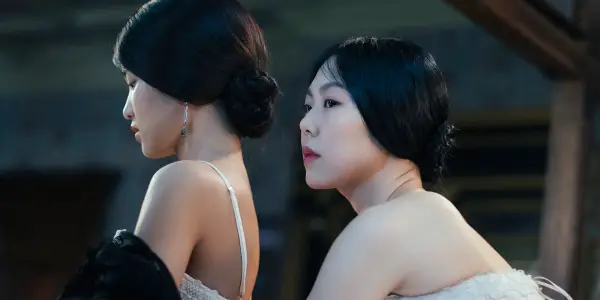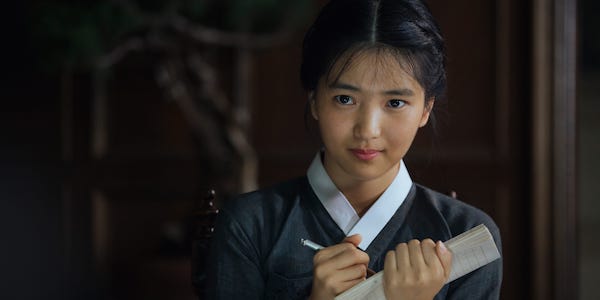The Realism of THE HANDMAIDEN: A Better Type Of Historical Fiction

Frances is a graduate of film and digital media from…
Let me tell you: I love a good romance film. One of my guiltier pleasures, a higher-caliber romance is punctuated with the perfect blend of angst, often-easily-avoidable drama, and sappy resolution. Given these traits, a good historical setting is prime for will-they-won’t-they tension and forbidden love. So when, many years ago, I discovered the queer historical romance genre, I was thrilled.
However, it gives me no pleasure to say that most of the historical queer dramas in my inventory have been disappointments. This is not to say that they were without merit, or lacking in any aspect of production. But what most of them rely on, as a central point of conflict, is the taboo of queerness.
Bury Your Gays
Cinema, in general, is known for the trope of “bury your gays,” wherein queer characters are killed far more frequently than straight characters. Several reasons for this include murder or suicide for the crime of queerness, and tragic — sometimes sensationalist — retelling of tragedies, like AIDS deaths. These often unnecessary deaths are nowhere easier to implement than in historical fiction, under the guise of “realism”.
One might argue that they are absolutely appropriate in a film based on real historical events, like a biopic. It is not to say that queer suffering is unrealistic, which unfortunately is not the case. But it is staggeringly limiting to tell the story of exile, exclusion, and sometimes acceptance to the point of painful rote.

Even in “happy” films like Carol or Tell It to the Bees, the audience must watch a (sometimes very pretty) historical landscape abuse queer characters, often in deeply violent and upsetting ways. Films like Brokeback Mountain, where history succeeds in beating down its characters, can be even more upsetting.
Exclusion in Historical Dramas
Outside of queer cinema, many historical dramas center white elites and no one else — a nickel for every British monarchy drama, or Pride and Prejudice lookalike. In these cases, queer and nonwhite voices are certainly excluded due to the glorification of the white elite and the desire for historical “realism”. This is deeply regrettable, largely because I happen to know very well that Pride and Prejudice is the quintessential lesbian aesthetic.
Of course, much of the straight white historical film has never been accurate. Characters are healthy and well-bathed, passionate yet austere, and certainly pleasant-smelling. I will not defend realism under any circumstances — these qualities absolutely improve historical films. But these liberties and many others show that exclusion does not genuinely serve historical realism, but only serves an aesthetic.
The Handmaiden
Park Chan-Wook’s The Handmaiden is an example of a beautiful, dramatic, liberating queer story nestled inside of a past that may never have precisely existed. Based on a Victorian-set contemporary novel, The Handmaiden is already removed from any unnecessary semblance of “historical accuracy”. Instead, this romantic psychological thriller appropriates a versatile story to the historical setting of its choice and further centers itself on a gripping plot rather than a taboo identity.

The Handmaiden contains no fewer than four major plot twists. Initially, our protagonist appears to be a young Korean woman who is to be sent as a handmaiden to a wealthy Japanese noble called Lady Hideko. She is poor, shy, and admires Hideko very much.
Twist Number One: The new young handmaiden, under an alias to the Lady, but Sook-Hee to the audience is not a handmaiden at all but a thief and a pickpocket. She is working with her boss, who poses as Count Fujiwara, an artist. The “Count” intends to market himself to Hideko’s uncle Kouzuki, who sells forgeries of rare manuscripts. Sook-Hee is charged with gaining Hideko’s trust and helping the Count seduce her, so he can inherit her fortune through marriage before throwing her into a madhouse.
Though Sook-Hee agrees to the ruse for a fair chunk of Hideko’s fortune, after arriving she becomes inconveniently attracted to the noblewoman. Hideko is naïve and innocent of the Count’s intentions, and Sook-Hee regrets manipulating her. Still, Count Fujiwara’s scheme is working, and he successfully seduces and marries Hideko. He arranges to withdraw her fortune and send psychiatrists to take Hideko away.
Twist Number Two: Instead of Hideko, Sook-Hee is captured and sent to the madhouse. The married couple having convinced the psychiatrists that Sook-Hee and Hideko have opposite identities, Sook-Hee is taken for a noblewoman gone insane. This initially feels like closure; a final betrayal. But there are still many untugged plot threads….
Twist Number Three: We are introduced to Lady Hideko again, but this time as a young girl. Her abusive uncle Kouzuki forces her and her aunt to read pornographic literature — his “rare manuscripts” — to audiences of men. She witnesses her aunt driven mad and then to suicide. (Twist Number Three and a Half: we later find out that her aunt was actually murdered, and she has been under the same threat all her life.)
Soon we see an older, very much not naïve Hideko meet Count Fujiwara, but this time before Sook-Hee arrives. The Count offers Hideko another deal, but an honest one, and the inverse of Sook-Hee’s bargain. He had intended to seduce her and steal her fortune but quickly realized that she was too clever for that. Instead, if Hideko marries him, the Count promises to escape from her uncle, to split the inheritance, and go their separate ways.
Hideko agrees, ordering the Count to get her a new maid, who they will send to a madhouse under the Lady’s name so she can start fresh. Unfortunately for Lady Hideko, she falls in love with the disposable handmaiden.

Twist Number Four: Before the marriage, Sook-Hee grows increasingly troubled, and tells Hideko the truth. In turn, Hideko tells her the truth. They decide to team up against the Count and form an escape plan for after Sook-Hee is sent away.
In this way, we are finally in the present again, and Sook-Hee escapes as planned. The two women successfully evade both the Count and Kouzuki, and sail away to live, presumably, happily ever after.
A New Narrative
The Handmaiden shows us that historical fiction doesn’t have to play by any established rules. Its setting works for it, not the other way around. Beautifully shot and directed, it is both a fascinating and inventive adaptation; its uniquely relatable characters are stronger for their new setting, yet not inwardly stifled because of it.
Gay angst is all very well, but The Handmaiden and many other stories have no use for it. Instead, it relies on a thrilling, crime-ridden plot and a deep exploration of its chosen setting. It is both historical and realistic, and yet its plot does not center on the taboo of queer love, because that is not necessary for the story.
I would plead queer filmmakers to think of The Handmaiden. Audiences are well-endowed with a suspension of disbelief, and we deserve nostalgic, beautiful, happy stories. We can use historical fiction to tell liberating narratives — not suffocating ones.
Broadening the Lens
Realism is sometimes warranted in fiction. However, in many cases, allowing a looser definition of “realism” or “historical accuracy” is appropriate. Yes, much of queer history involves suffering. This story has been told many times. Why make your audience view the same tragedy over and over?
Fiction should cast the widest net, allowing as many unrealistic or wish fulfillment stories as we like. We can have tragedy beside comedy, beside ecstatic fantasy. We should demand the joyful stories of queer medieval queens and rebels who run away together, or of horse-riding lesbians on a large estate who send each other pining letters. We should demand stories where the protagonists are already comfortable in their identities, and must instead complete some adventure or overcome a Shakespearean misunderstanding to be together.
Historical fiction and its fallacious realism do not often serve the queer community, and we should unburden ourselves from them. Then, adopting whatever historical setting we prefer, we can tell mesmerizing stories without sensationalism, their queer romance instead simply sewn into the seams.
What’s your favorite historical queer story? Do you think realism helps or hurts queer creators and audiences? Let us know in the comments below!
Watch The Handmaiden
Does content like this matter to you?
Become a Member and support film journalism. Unlock access to all of Film Inquiry`s great articles. Join a community of like-minded readers who are passionate about cinema - get access to our private members Network, give back to independent filmmakers, and more.
Frances is a graduate of film and digital media from California. She enjoys watching and expounding theories on cinema, especially when experimental or directed by women. In her spare time she enjoys reading short stories and writing queer fantasy.












